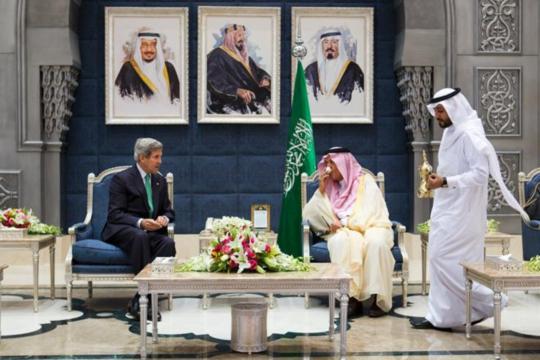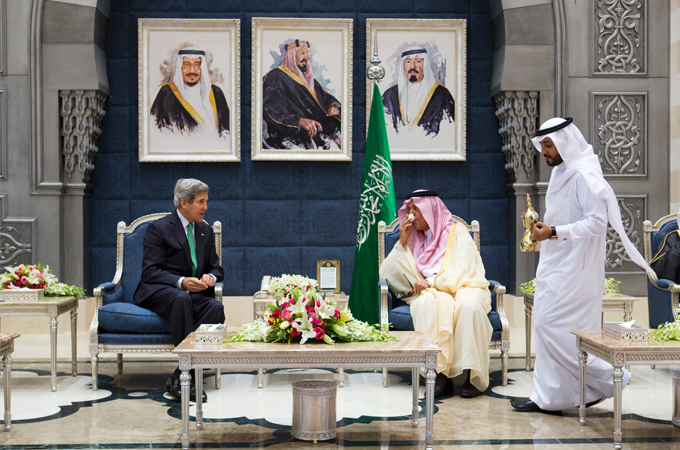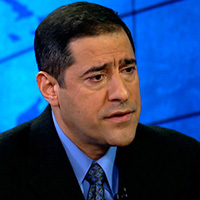
 |
| U.S. Secretary of State John Kerry, left, attends a coffee ceremony with Saudi Foreign Minister Prince Saud al-Faisal as a welcome upon Kerry's arrival in Jeddah, Saudi Arabia [AP] |
| Abstract
John Kerry’s latest visit to the Kingdom of Saudi Arabia (KSA) came as a response to the rising tension between the United States of America (USA) and the kingdom over USA policies in the region. The Saudis have been frustrated with American policies on Bahrain, Egypt, Iran, Iraq, and Syria. Riyadh is anxious about the new role of Iran in the region, especially after it has been legitimized by the Geneva accord. The KSA feels disregarded and not consulted enough by a key strategic ally on issues of grave national security concerns to the Kingdom and the region. |
Introduction
Saudi-American tension emerged when the KSA abruptly canceled an annual customary speech at the United Nations General Assembly (UNGA) on October 2013, (1) and the rift grew wider when the Saudis rejected a two-year seat to the UN Security Council in mid-October 2013. (2) The Saudi discontent with American policies in the region surfaced after the USA handed Iraq to a Shiite coalition with close links to Iran and did not prevent Iran from having a free hand in Iraq. Saudi disgruntlement accelerated after the Americans failed to thwart the deposing of Hosni Mubarak from power. The reluctance of the USA to punish Assad for using chemical weapons against Syrian civilians and its unwillingness to deter Iran from sending fighters and supplies to the Syrian regime signaled a new shift of American priorities and the emerging of a new balance of power in the Middle East. Hence, the kingdom began to change its priorities and threatened to reassess its alliances.
Saudi-American Tension over Iran
Saudi frustrations with Iran began to surface after the dethroning of the Shah in 1979. (3) Iran’s objectives since the 1979 revolution have been to export its ideology, seek a Shiite revival, reconstruct itself as the only hegemon in the region, and manipulate the discourse to legitimize its religious and political narratives. These pursuits have irritated many countries in the region and around the world especially the KSA. (4) Any rise of Iran’s revolutionary agenda will shift the balance of power in the region and that will have perilous ideological and geopolitical implications for the kingdom and its allies. (5)
Ideologically, Iran has always dreamed of speaking on behalf of all Muslims around the world-- especially the Shiites--and wished to dominate the holy sites in Mecca and Medina. (6) In addition, Iran has always challenged the hegemony of Sunni Islam on the rituals during the pilgrimage and other practices around the world. Competition for Islamic control and dominance of narratives has manifested itself over the last three decades between the KAS and Iran. The rivalry has been between two distinct ethnicities--Arab and Persian-- and between whose approach has the legitimacy to lead. Thus we have witnessed a strong and clear Saudi support to Sunni protesters in their struggle in Syria, Libya, and Yemen, whereas Iran has been supporting the Shiite in Syria, Yemen, and Bahrain. (7)
Politically, Iran aspires to be the hegemon in the Gulf and the Middle East at large at the expense of the KSA and has been pursuing nuclear power to ensure that. If and when that happens, Iran would shake the equilibrium of power and manipulate the entire region by controlling the price and amounts of oil produced and exported from the region by employing more OPEC members to serve its agenda. In addition, Iran would have a bigger role over the Straits of Hormuz; the only water outlet for export and import for many Arab countries in the Gulf. Finally, a hegemonic Iran would further destabilize Iraq, Lebanon, Syria, Yemen and the process by working the sects against each other. (8) Since the Khomeini revolution, Iran has been using soft and hard power to advance its agenda in the region.
Iran’s soft power is best demonstrated in the Israeli-Palestinian conflict. Iran has captured the minds and the hearts of many by refusing to deal with Israel and by using fiery rhetoric against it and the West. There is a perception by many of Iran as the only country willing to stand up to the USA and the West at large. Neither the KSA nor any other Arab country can behave like Iran on such issues. Also, Iran does not shy from using hard power to achieve its goals: the arming of Hezbollah and many Iraqi militias is a clear example of that. (9)
Saudi-American Tension over Egypt
The American unorthodox response to force a traditional ally from power has irked the KSA. The kingdom had in Mubarak a stalwart ally especially on containing Iran and curtailing its ambitions in the region. The KAS and the Mubarak regime shared interests in suppressing and dissuading the Muslim Brotherhood by banning and limiting its activities in the Middle East. The Saudis perceive the Brotherhood as a competitor which threatens their dominance over Islamic law and teachings, and Mubarak viewed them as formidable enough to delegitimize him and rule Egypt. Therefore, when the Obama administration gave Mubarak the final nudge to leave power, the Saudis couldn’t hide their discontent with such a policy. (10)
The Saudis and Mubarak saw eye-to-eye on many issues, especially Iran. Mubarak just like the Saudis treated Iran as a competitor. Mubarak feared Iranian drive for regional domination. Mubarak refused to revive Egypt’s diplomatic relations with Iran and kept all other contacts at minim. Iran’s constant attempts to derail the Israeli-Palestinian peace process and its flagrant and intrusive military and political interventions in Lebanon brought many condemnations from Cairo. Therefore, the KSA was perplexed when the American didn’t prevent the collapse of Hosni Mubarak, a reliable and formidable ally, who worked tirelessly to bock Iran from realizing it objectives. (11)
All this began to change gradually when Mubarak was toppled, the Iranians could not hide their exuberance. The new regime in Egypt expressed its desire to open a new chapter with Iran, and as confidence building measure they allowed Iranian warships to pass through the Suez Canal. The ruling military council which succeeded Mubarak and the democratically elected Morsi administration viewed with favor the gradual revival of Egyptian Iranian diplomatic relations. This shift in Egyptian policy gave Iran a new and additional platform in the Middle East and increased its mobility in the region. (12) It also brought Iran closer to the Red Sea basin an achievement Mubarak would have never allowed.
Saudi-American, Tension over Iraq
The American occupation of Iraq in 2003 altered the socioeconomic foundation of the country and resulted in turning Iraq into a battleground between Iran and many Arab Gulf states, especially the KSA. Iran capitalized significantly on its political, economic, and cultural relations with a large segment of the Iraqi population and began infusing its power by financing projects, lending expertise, forming political parties, coordinating with Shiite elites, and exporting Shiite-trained clergy from Iran to Iraq. (13)
Through the clergy, Iran began gradually filling the power vacuum that the Sunni elites left by assisting the Shiite groups of forming and assembling influential political parties. For instance, Iran played a critical role in assembling the Shiite Islamic bloc (United Iraqi Alliance) which included the Islamic Supreme Council of Iraq (ISCI), the Da’wa Party, and the Moqtada Al Sadr party. The leaders of this block, Nuri Kamal Al Maliki, Ibrahim Al Jafferi, and Moqtada Al Sader who descends from one of the most influential Shiite families in the Middle East, have been running Iraqi politics in close coordination with Iran. (14)
Having presence in Iraq allows Iran to have access to Saudi land and easier contacts with Saudi Shiites. This represents the biggest disadvantage to KSA and could easily turn into a direct challenge and threat against the kingdom and its interest in the region. In addition, the American occupation of Iraq has given Iran an open land corridor to Syria and in turn to Lebanon and the Mediterranean Sea. This has bolstered the strategic depth of Iran and allowed it extra routes for supplies to down play any impact of economic sanctions and alternate routes of exports.
Saudi-American, Tension over Syria
Syria provides a compelling example of the growing competition between the KSA and Iran for regional influence and the kingdom’s dismay and growing rift with Washington. (15) When the Syrian people rose to seek dignity and freedom, the Iranians rushed to defend their ally in Damascus with all their might. The Iranian government sent cash, arms, fighters, oil, and many technical experts to shore up the regime of Bashar al-Assad. (16) In addition, the Iranians, through lucrative arms and energy deals, enticed the Russians to protect the regime and ensure its longevity under the watchful eyes of the West. (17)
The Iranians became bolder and began using Iraqi airspace to send weapons to the Syrian regime. Using Iraqi airspace hit the news waves after the Iraqi foreign minister Hoshayer Zebari said, “We reject and condemn the transfer of weapons through our airspace and we will inform the Iranian side of that formally. But we do not have the ability to stop it.” (18) The foreign minister’s statement was directed at the USA and other Western powers.
Zebari’s conscious announcement raises two fundamental facts. First, Iran’s power is growing at the expense of all regional actors and the West is complicit in that. Second, the Iraqi government is neither capable nor willing to stop Iran from changing its behavior. Zebari’s statement put the America’s on the defensive and forced them to promise to prevent Iran from using Iraqi air space by exerting pressure on the Iraqi government to no avail. (19) The lack of clarity in American policies in Syria and Iraq have caused uproar in the region and made many speculate about America’s true intentions in the Middle East.
America’s dithering on Iran and Syria caused many to question America’s credibility and trustworthiness, and promoted a committed ally like Saudi Arabia to announce through Prince Bandar, that the kingdom will make a “major shift” to protest America’s inaction over Syrian’s civil war and American overtures to Iran. (20) The American inaction in Syria will force many friendly countries to rethink and reassess their alliances with the USA.
American wavering on Syria and Iran emboldens rivals like, China, North Korea, Russia Venezuela and other ambitious powers to challenge the USA and it policies around the world. The Chemical Weapons agreement with the Assad regime and the Geneva agreement with the Iranian regime harm America’s image and credibility among rivals and allies alike. Many argue that the Obama administration has been shallow enough to deconstruct the Syrian catastrophe to a question of chemical weapons, and all Iranian expansionist and hegemonic policies to a shaky détente that could give Iran more resources and time to complete its nuclear project with Western money, technology and blessings. The legitimization and rehabilitation of the Iranian and the Syrian regimes reflect an ever widening gap between the America’s strategic commitments and the resources available to maintain them.
Saudi-American Tension over Bahrain
Saudi American relations have also suffered a setback over the protests in Bahrain. The United States viewed the demonstrations as pro-democracy protests, while the KSA and other Gulf states saw the invisible hand of Iran controlling and directing the events. Bahrain’s location, economic relations, historical past, and demography required a stern response and an overruling of any America’s objection to Saudi and Arab responses to protect the kingdom of Bahrain from suffering the fate of Iraq, Lebanon, Syria, and Yemen at the hands of Iran. (21)
Bahrain’s location forced the KSA to consider any threat to Bahrain as an existential threat to itself. Bahrain is connected to the city of Al Khobar via the King Fahad Causeway and a great deal of daily traffic takes place between the two kingdoms. Thus Bahrain’s security is Saudi security. (22) In a cost benefit analysis, Saudi Arabia has a great deal to lose from staying passive on Bahrain and allow the American vision to prevail.
Bahrain’s economy and the size of trade between the KSA and Bahrain are very large. The two countries have joint tourism, banking, petroleum, financial centers, and real estate projects. Therefore, the KSA cannot allow Iran to have a free hand in Bahrain and threaten its national security interests the way Iran has been in controlling Iraq. (23) Since coming to Iraq, Iran has agitated the sectarian violence and supported Shiites against all others especially in the South of the country.
Considering its history, Saudi fears over Iran’s ambitions to control Bahrain are justified. Many Iranians have expressed their intentions of making Bahrain their fourteenth province. Iranian newspapers and some politicians express these desires often and insist that Bahrain is an Iranian territory. This threat is coupled with a demographic one; Almost 60% of Bahraini citizens are Shiite and Iran aspires to have control over them. (24) Therefore, the strategic decision of the KSA to rebuke the USA for its expressed sympathy to the protesters in Bahrain must be understood in relation to America’s failure to deter and contain Iran from tampering with the political and security situation in Iraq, Lebanon, Syria, and Yemen. Hence, many states in the Middle East feel that they must defend themselves because the USA is neither reliable nor credible.
Conclusion
American policies in the Middle East over the last decade complicated Saudi-American relations and inadvertently bolstered Iran at the expense of Saudi Arabia and other Arab Gulf states. In Iraq, the Americans failed to establish a democratic non-sectarian government. They succumbed to the Iranian-backed Shiite coalition ISCI that convulsed Iraq’s relations with all its neighbors and heightened the Shiite/Sunni divide in the country. Iranian hegemony over Iraqi politics changes the balance of power in the region and brought Iran in direct geographic contact with many Arab states.
The American reluctance to confront Iran in Iraq encouraged Iran to sail west to Syria and Lebanon. Since the crisis in Syria, America has been wavering in its response to stop the bloodshed and deter Iran from getting involved. America’s foot-dragging in Syria paved the way for Iran to shape events in Syria and become indispensible. Iran’s political clout is increasing at the expense of the KSA and other Arab countries due to American’s retreat and a growing perception in the Middle East of a widening gap between America’s commitments and the resources allocated to maintain them. The perception of America doing less will encourage many to step in to fill the power vacuum in the Middle East. Iran and the Russian Federation are eagerly doing so.
_________________________________________________
Copyright © 2013 Al Jazeera Center for Studies, All rights reserved.
*Dr. Ghassan Shabaneh is an Associate Professor of Middle East and International Studies at Marymount Manhattan College in New York City.
Endnotes
(1) R. Gladstone (2013) In a First, Saudi Cancel a Speech at the UN. The New York Times, October 3, 201 http://www.nytimes.com/2013/10/04/world/middleeast/in-a-first-saudis-cancel-a-speech-at-the-un.html?_r=0
(2) E. Voeten (2013) Why Did Saudi Arabia Reject a UN Security Council Seat. The Washington Post, October 18, 2013. http://www.washingtonpost.com/blogs/monkey-cage/wp/2013/10/18/why-did-saudi-arabia-reject-a-un-security-council-seat/
(3) E. Ersoy (2012), The Rivalry between Saudi Arabia and Iran in the Middle East. The Journal of Turkish Weekly, December 2, 2012. http://www.turkishweekly.net/news/146072/the-rivalry-between-saudi-arabia-and-iran-in-the-middle-east.html
(4) Words of Khomeini: On Islam, The Revolution and Cease-Fire. (1988), The New York Times. http://www.nytimes.com/1988/07/23/world/words-of-khomeini-on-islam-the-revolution-and-a-cease-fire.html?pagewanted=all&src=pm
(5) K. Soltani (2013) Iran-Saudi Arabia: a troubled affair. Al Jazeera English November 20, 2013. http://www.aljazeera.com/indepth/opinion/2013/11/iran-saudi-arabia-troubled-affair-2013111961213978211.html
(6) S.M.AL Tamamy (2012) Saudi Arabia and the Arab Spring: Opportunities and Challenges of Security. Journal of Arabian Studies, December, Vol 2 (2), pp 145. http://www.tandfonline.com/doi/pdf/10.1080/21534764.2012.734117
(9) E. Chorin & H.Malka (2008) Iran’s Soft Power Creates Hard Realities. Center for Strategic and International Studies. April, 15, 2008. http://csis.org/files/media/csis/pubs/0408_menc.pdf
(10) M. Ambinder (2011) A White House Policy on Egypt Evolves. National Journal. February 1, 2011. http://www.nationaljournal.com/whitehouse/a-white-house-policy-on-egypt-evolves-20110201
(11) B. Birnbaum (2010)Mubarak: ‘Iranian influence spreading like a cancer’ across Arab world. The Wsshington Time. December, 15. 2010. http://www.washingtontimes.com/news/2010/dec/15/mubarak-iranian-influence-spreading-cancer/
(12) A. Morrow. M. al-Omrani (2011) Post-Mubarak Egypt Inches Toward Iran. Anti-War.Com. June, 28, 2011. http://original.antiwar.com/morrow-omrani/2011/06/27/post-mubarak-egypt-inches-toward-iran/
(13) K. Pollack (2011). Prospects for Increased Iranian Influence in Iraq. Brookings. November, 15, 2011. http://www.brookings.edu/research/testimony/2011/11/15-iran-iraq-pollack
(14) E. Knickmeyer (2005) Iraqi Alliance Seeks to Oust Top Officials of Hussein Era. The Washington Post, April 18, 2005. http://www.washingtonpost.com/wp-dyn/articles/A61487-2005Apr17.html
(15) R. Worth (2013) U.S. and Saudis in Growing Rift as Power Shifts. The New York Times. November 26, 2013. http://www.nytimes.com/2013/11/26/world/middleeast/us-and-saudis-in-growing-rift-as-power- shifts.html?_r=0
(16) L. Charbonneau (2013) Exclusive: Iran steps up weapons lifeline to Assad. Reuters, March 14, 2013. http://www.reuters.com/article/2013/03/14/us-syria-crisis-iran - idUSBRE92D05U20130314
(17) B. Fallon (2013) Possible Russian-Iran Arms Deal: Leverage Against US Syria Strike. IVN, September 14, 2013. http://ivn.us/2013/09/14/possible-russia-iran-arms-deal-leverage-against-us-syria-strike
(18) Iraq Says It can’t Halt Arms to Syria (2013) The New York Times. July 13, 2013 http://www.nytimes.com/2013/07/14/world/middleeast/iraq-says-it-cant-halt-arms-to-syria.html
(19) M. Gordon & T. Arango (2013) In ‘Spirited’ Talks, Kerry Tells Iraq to Help Stop Arms Shipments to Syria. The New York Times. March 24, 2013. http://www.nytimes.com/2013/03/25/world/middleeast/baghdad-kerry-iraq-arms-shipments-to-syria.html?pagewanted=1
(20) J. Coyle (2013) U.S. losing Saudi Arabia as an ally. The Orange County Register. November 18, 2013. http://www.ocregister.com/articles/saudi-537594-united - prince.htm
(21) Ibid
(22) M. Nuruzzma (2013) Politics, Economics, and Saudi Military Intervention in Bahrain. Journal of Contemporary Asia. Vol 43 (2), pp, 367.
http://www.tandfonline.com/doi/pdf/10.1080/00472336.2012.759406
